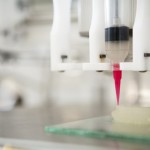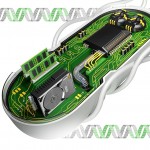Glossary
The following is a list of terms or phrases which might be useful for the understanding of content on this site. This list is by no means comprehensive, if you think I should add something to this list please contact me.
- Allele – a ‘form’ of a gene. For example you might have a gene for hair colour, which has multiple alleles – each of which codes for different colour.
- Amino Acid – a set of molecules which in sequence make up proteins. Each amino acid is represented in a gene by a specific codon.
- Artificial Life – not to be confused with synthetic life, artificial life is the simulation of life within computer based models. This means the study of “life” in different worlds to ours. For example, one could look at types of “life” within a cellular automata.
- Artificial Selection – the process whereby humans select which of a set of organisms can breed and which cannot, effectively breeding for or against certain traits. This is the oldest form of genetic engineering.
- BioBrick – A standardised sequence of DNA which has defined input and output, used to help abstract and standardise genetic engineering to make it easier.
- Biopunk – Originally a science fiction genre (being a sub-genre of cyberpunk), but now also a technoprogressive social movement advocating open access to genetic information.
- Codon – codons are sequences of three nucleotides which encode a single amino acid in a protein sequence. There are more codons than there are amino acids, so some codons are linked to the same protein (this is a form of natural biological redundancy).
- DIY Biology – Do it yourself biology, a movement to include the broader public in genetic engineering – taking inspiration from computer hackers and hobbyists.
- DNA – deoxyribose nucleic acid, a very small double helix made up of a sugar backbone and a sequence of four nucleotides (Adenine (A), Cytosine (C), Thymine (T), Guanine (G)). DNA can be see as the set of instructions for life, encoding the proteins used by cells to replicate and maintain themselves. DNA is usually double stranded, with both strands of its DNA being the reverse complement of each other.
- Epigenetics – Meta-regulation of gene expression by potentially heritable modifications to DNA (such as DNA methylation or histone modification) which do not change the sequence of DNA itself.
- Evolution – a natural process whereby mutations and recombinations of DNA change in frequency in a population over time due to the differential fitness they confer. Evolution explains the vast diversity of life on Earth and is notably a non-random, non-directed process.
- Gene – A section of DNA which encodes for a single protein.
- Genetics – The study of genes, heredity and biological diversity.
- Genetic Engineering – the direct human manipulation of an organism’s genome using modern DNA technology. This process involves the introduction of foreign DNA into the organism of interest. Organisms created in this way are known as genetically modified organisms (GMOs).
- Genome – All of the DNA within a single cell, the set of all of the genes an organism has.
- Genomics – The study of the interactions between large numbers of genes within an organism, less concerned with heredity the most genetics.
- Genotype – The genotype is the genetic makeup of a cell, an organism, or an individual (i.e. the specific allele makeup of the individual). It is often used to distinguish traits of the genome with traits of the phoneme.
- GMO – Genetically modified organism, an organism which has been created through genetic engineering.
- Horizontal Gene Transfer – also known as lateral gene transfer is the process by which genes are able to transfer between organisms. This is distinct from normal (vertical) gene transfer where genes can only transfer from parent to offspring. Horizontal gene transfer is the natural form of genetic modification and it happens quite regularly. It also raises security concerns of introduced genes potentially transferring into natural populations through this process.
- Natural Selection – the natural process whereby some organisms in a population will have more offspring than others – thus modifying the relative frequencies of certain alleles in future generations. Natural selection is an important driving force behind evolution.
- Open Science/Biology – is a movement to make scientific data/research publicly available as much as possible. In biology there are specific ideological struggles over the role of intellectual property of living things. Open biology advocates that living things should not be able to be patented but critics claim that this will stifle economic incentive which is necessary for the field to grow.
- PCR – Polymerase Chain Reaction. A process used to amplify a small amount of DNA, essential for a large number of biotechnologies.
- Phenotype – A phenotype is the composite of an organism’s observable characteristics or traits: such as its morphology, development, biochemical or physiological properties, phenology, behavior, and products of behavior (such as a bird’s nest). Phenotypes result from the expression of an organism’s genes as well as the influence of environmental factors and the interactions between the two.
- Protein – a piece of cellular machinery. Each cell is made up of proteins which are created by ribosomes from the instruction set in an organism’s genome. Proteins are made up of a sequence of amino acids
- RNA – ribonucleic acid, is like DNA but is slightly less stable and is often found in a single strand. RNA does not have the base Thymine (T) and instead has the base Uracil (U). Within the cell there are a few main types of RNA: messenger RNA (mRNA) & transfer RNA tRNA are used as intermediaries between genomic DNA and proteins; RNA can also be used structurally as in the case of ribosomal RNA (rRNA), acting similar to a protein; finally RNA can also be used by the cell as a regulatory element, modifying gene expression as in the case of miRNA and siRNA.
- Sequencing [of DNA] – “Reading” the sequence of a specific section of DNA, this is very difficult to do given the tiny size of DNA, but modern technology uses very clever methods to do this quickly and cheaply.
- Synthesis [of DNA] – “Writing” a section of DNA from scratch. This allows us to create important sections of DNA such as primers. Or even to create genes and maybe even entire genomes from scratch.
- Synthetic Biology – is a new wave of genetic engineering which seeks bring the field more inline with traditional engineering practices such as standardization and abstraction. It can also refer to the quest to make life from scratch.
- Transhumanism – is a social movement based around the premise that it is desirable for humans to genetically engineer themselves to be better. It distinguishes itself from eugenics by advocating the use of modern technology to modify humans, rather than through artificial selection applied to humans.













